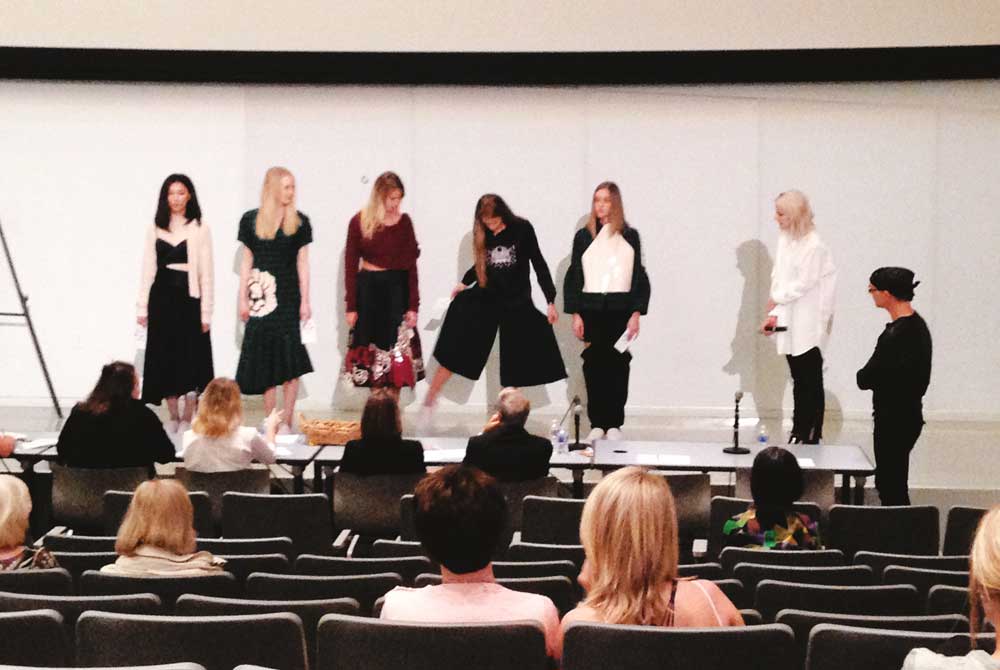This is not what I expected. After wandering the halls of University of Cincinnati’s Design, Art, Architecture, and Planning (DAAP) building, I drifted into room 4400, a lecture hall with maybe 40-50 people occupying the 200 or so seats. Six judges are seated at a table facing the stage at the bottom of the auditorium, where a line of young women stand dressed in quirky, structured designs: a green plaid dress with a stiffly flared skirt, a boxy top with a full calf-length skirt. A young woman holding a microphone–designer Caroline Huth, I assume–stands at the side of the stage, and I vaguely hear her mention that the calf-length skirt is actually a pair of culottes. The model wearing the culotte-skirt kicks a leg up to demonstrate that they are, in fact, pants. The judges ooh and aah in approval.

How it works
I’m not sure exactly what I expected from DAAP’s senior critiques, or “crits” as the students and faculty call them, but this cross between American Idol and Project Runway seems perfectly appropriate. Here’s how it works: seniors graduating from the fashion program present their final thesis collection to a panel of judges, who critique everything: color palette, fabrics used, proportions, in addition to the way the clothes are styled and accessorized. The young designers have the opportunity to talk about the inspiration behind their designs and respond to any questions the judges have. There’s a limited amount of time (though several of the crits I saw went over), so the designers have to be at the top of their game–difficult when all-nighters in the studio have become a way of life. The feedback from the judges will be used to perfect each look for the big runway show. It’s a pretty big deal.
Kids in the hall

Next up is Megan Harmeyer, who explains that her collection is influenced by Taoism and was designed with androgyny and a spectrum of body types in mind. Eight waifish men walk onstage wearing fluid, tailored garments layered in an almost architectural fashion, all in neutrals like sand, chambray blue, and black. One piece, a pair of knee-length shorts with clean lines and an angular flap across the front is paired with a hand-embroidered shirt and impeccably cut jacket that manages to be tailored and relaxed at the same time. Harmeyer explains that she also made the simple sandals some of the models are wearing. The judges can’t get enough. On a scale of 1 to 5, “I give it a 6” says one judge, designer Azhand Shokohi. I agree: the collection is flawless.

Student-designer Ryan Seminara heads to the stage, noting that his collection of shiny round-shouldered dresses and wide-legged pants in reflective Yves Klein blue, bright raspberry, and acid yellow is inspired by artist Jeff Koons. “This palette is SO strong,” says judge Thomas Liddy, who stalks the stage offering encouragement and criticism. On stage, a model starts to sway, and Seminara holds her up while someone rushes a chair up to the stage before she faints. Apparently, fainting is not unusual. “This happens every crit,” notes adjunct professor Randy Wilson.

Connor Devoe takes the stage with a troop of models attired for what he describes as fashion for The New Order–otherwise known as living on a spaceship. His collection of putty-colored neutrals in minimal shapes include a hand-knit sweater and alien-like tessellated leather accents on the sleeves of a men’s blazer and strategically peeking out under a sleek suede pencil skirt. It is amazing. “You’re killing me,” sighs one judge rapturously, as everyone around me agrees to Google tessellation.
Always judging
What’s so impressive to me is the lack of costume-y, over-styled designs that can permeate student collections. I ask judges Annie Wehby and Megan Blau, both Amazon stylists, what they look for in designers. “Their designs should demonstrate an elevated level of taste,” says Wehby. As judges, they look at the concept, execution, and cohesiveness of the collection. “Design is different than art in that it has to be functional,” points out Blau.

I creep backstage, where designer Veronica Coredero is waiting for her turn to present her collection influenced by Enyo, the Greek goddess of war. She’s chatting nervously with her models and I ask to take a few pictures of her dresses, a mixture of chiffon, metallic leather, and maille.
“You’ll do great,” I assure her. She smiles, takes a deep breath, and heads to the stage.
The DAAP Fashion Show is Friday, May 1st at 7:30pm. Tickets for the show are nearly sold out, but you can buy tickets to Thursday’s dress rehearsal, or watch the live stream online or on the big screen at Fountain Square.




Facebook Comments